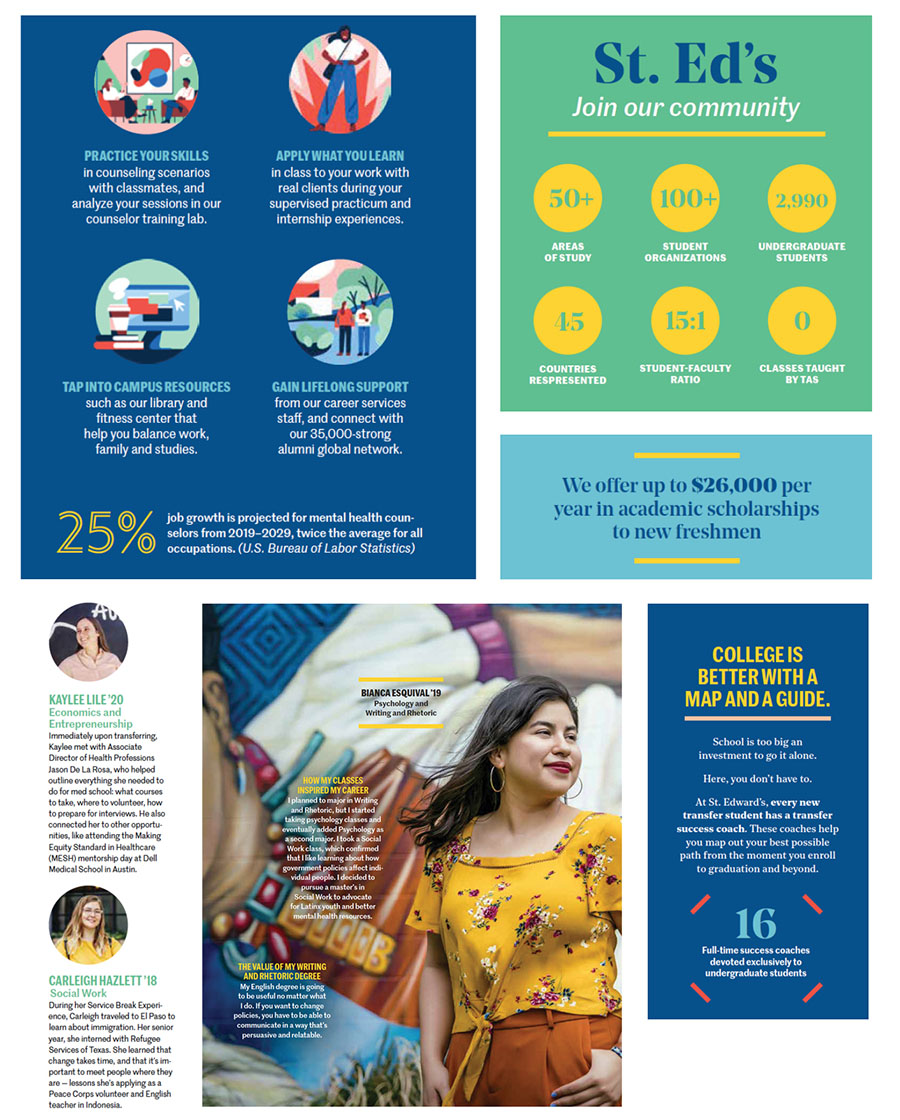Our brand platform provides the framework for how we talk and write about St. Edward’s and the evolving student experience on the hilltop.
How Our Brand Platform Has Evolved
Over the past two decades, St. Edward’s has embarked on a series of strategic plans that have identified the university’s goals and objectives and defined our vision for the future. With each new version of the strategic plan, our brand platform is updated to support the plan’s priorities and provide a foundation for consistent messaging.
Strategic Plan 2027 brings a bold new vision and set of goals that position St. Edward’s as a Destination University for a More Just World. Our brand platform(pdf) guides our community and provides examples for speaking in a united voice about the university as we work together to achieve our goals.
How to Use the Brand Platform
We encourage you to refer to the brand platform when developing a presentation, submitting a grant application, crafting an email or speaking to prospective students. Refer to the brand platform when creating:
- Emails
- Social media content
- Webpages
- Print pieces
Benefits of Prioritizing Key Messages
- Creates consistent, quality impressions of our university across multiple channels
- Strengthens our brand and reputation in the marketplace
- Establishes trust and credibility across audiences
Key Audiences
We know what makes the St. Edward’s community special, and we share our story to build meaningful engagement with our audiences. To achieve this, we must know how to appeal to each audience: undergraduate students, graduate students, parents, faculty and staff, alumni, trustees, and partners and donors.
Highlights from the Brand Platform
University Vision
St. Edward’s University, a Holy Cross, Catholic institution, will improve lives and transform communities by providing an excellent education of distinguished quality that prepares students to create a more humane, just and sustainable world.
University Brand Promise
St. Edward’s offers an outstanding university experience driven by academic excellence and dynamic experiential learning opportunities. We foster passionate innovators and problem-solvers who improve our communities and create a more just and sustainable world.
Tagline
Take On Your World
Our tagline communicates our brand promise in a succinct and memorable phrase. It is used in select cases with the St. Edward’s University logo, as a stand-alone statement or as a powerful ending punctuation to our stories. We avoid using our tagline in headlines. We use it sparingly in copy.
Brand Attributes
These brand attributes are the core characteristics that inform the brand essence and help capture our university’s unique qualities and personality wholistically.
- Creative thinkers
- Agents of change
- Ethically minded
- Community focused
- Globally aware
Brand Tenets
With every touchpoint, relationship and interaction, we see St. Edward's impact on our community members and our partnerships beyond the hilltop. Our brand tenets reflect these experiences and serve as the core principles that propel our university forward.
- Academic Excellence and Distinction
- Vibrant, Inclusive and Justice-Seeking Community
- Austin Impact and Innovation
- Achieving at the Highest Level
Learn more about our Brand Tenets and how to use them effectively.
Voice and Tone
As the St. Ed’s community works together to achieve Strategic Plan 2027, we must present a purposeful, clear and unified voice to our audiences around the world. By keeping tone in mind when creating communications, you will contribute to a higher standard of consistency and uniformity that will enhance the university’s reputation and brand.
Our tone is:
- Authentic
- Confident
- Friendly / conversational
- Optimistic
- Sincere
- Thoughtful
Refer to our Editorial Style section for common questions about grammar, proper forms of university-specific terms, locations and descriptions, and guidelines for style and writing effective copy.
Creative Concept
Live Fully
The creative concept is an emotional translation of the positioning and key messages. This is not a tagline or a headline — think of it more like a campaign. One example is Nike. The brand and tagline — Just Do It — is long-standing and well-known, but several creative campaigns over the years (Find Your Greatness, Seen It All, Unlimited You) have propelled their products and position forward through different changes in the marketplace.
At St. Edward's, students can pursue their goals, achieve at the highest levels, experience unparalleled academics and thrive in an inclusive community committed to social justice. All while having a mutually beneficial relationship with the dynamic city of Austin. Students get a full college experience at St. Edward's, a destination university where they can live fully.
Guidance for Use
"Fully" should be tied to an action verb that supports the brand pillars. Adjectives can be used with bolder statements:
- Powerfully
- Skillfully
- Meaningfully
- Insightfully
- Successfully
- Helpfully
- Artfully
- Gleefully
- Zestfully
Language around the creative concept, such as "live fully" or "go full on," should be limited in a piece — they should only be used 1-2 times. These should not solely be used for headlines but rather be woven into supporting copy. For example:
- "At St. Edward's University, our students go full on once they step through the Red Doors, with internships, experiential learning and vibrant campus traditions."
Remember to utilize language and key messages from the brand platform to support the creative concept.
Proof Points
Messaging in communication pieces should be supported by proof points that back up the things we say about our brand. Proof points can be achieved through:
- Breakout profiles of students and alumni
- Stats
- Testimonials
- Relevant, personal content
- Visuals, such as photos, videos, maps, etc.
Guidance for Use
Proof points should be:
- Relevant to the audience
- As evergreen as possible
- Fact and source checked
- In succinct, easy-to-understand formats
Think creatively when presenting proof points. For example, could a testimonial be a static quote as well as an audio clip from a student?

Visual examples of proof points in use

Hilltopper Successes and Achievements Submissions
The St. Edward's community is rich with stories demonstrating the highly personalized university experience, transformative opportunities for students and the innovative ways faculty, staff and our alumni impact the community. If the information you provide is used for marketing content or success reports, we may contact you for additional details. Thank you!
